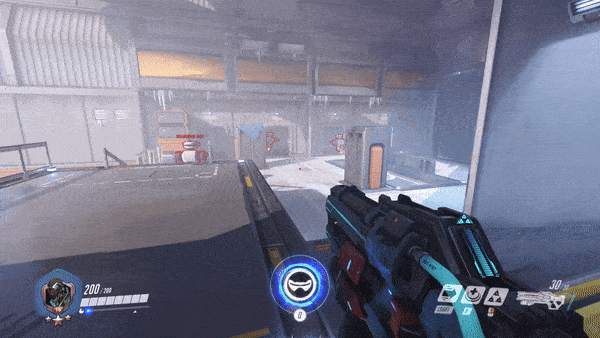Hitscan refers to a gunplay mechanic where-in simple calculations are used to determine target hits in shooter games. Hitscan uses raycasting technology to cast a straight ray from the gun's muzzle to the next point of contact. It does not fire an actual bullet from the gun but instead uses 2D imaging to determine a hit on a particular target.
This article will define hitscan and its various applications. It will differentiate hitscan from more advanced gunplay mechanics called projectile ballistics. It will also list games that use hitscan, projectile ballistics, and a hybrid system that combines hitscan and projectile ballistics.
What is Hitscan?

Hitscan refers to the simple gun mechanics used in shooter games to determine whether a player hits a target or not.
It uses a method called raycasting to translate a 3D environment into a 2D plane and shoot a straight line from Point A, the gun, and Point B, the next point of contact. If the straight line intercepts the player's target object, this will register as a hit.
Furthermore, raycasting occurs at the speed of light. This means that the straight line cast from point A to point B occurs instantaneously. Thus, firing a shot from the gun will instantly deal damage to an opponent if successfully hit.
Hitscan only takes into consideration several points: the direction of the gun, the firing instance, and the register of the shot on the point of contact. At first glance, this seems to be the appropriate method to calculate hits in shooter games. It is the simplest mode of calculation to determine and ascertain hits.
Most casual shooter games employ hitscan as its gunplay mechanics. However, this can be simplistic and feel unrealistic for some players. Its simplicity provides an advantage for processing and does not require powerful devices to determine hits. It is also possible to add certain dynamics such as hitting multiple targets in a straight line or ricocheting off reflective surfaces.
Hitscan, however, does not simulate the actual mechanics of firearms. It does not take into account other variables that can affect hit or miss like gravity, wind, bullet velocity, distance, and time traveled. It presents a simple learning curve for shooter games but can fail to add realism to your experience.
Projectile Ballistics
Projectile Ballistics is the alternative to hitscan for gunplay mechanics. It adds elements of realism to shooter games by incorporating various dynamics that can influence hit or miss. For instance factors like gun recoil and shot distance.
As a result, sniping in games that use projectile ballistics as its primary mechanics require the player to shoot above the target in order to account for distance, gravity, and bullet velocity.
It also eliminates the instantaneous bullet travel speed. As such, different types of guns with different types of caliber ammo have different travel speeds from the muzzle to the target.
Guns like pistols and submachine guns will have lower caliber bullets and therefore have shorter travel speed and distance than assault rifles and sniper rifles. This will immensely influence gameplay as the player is forced to choose different weapons for different scenarios.
The main mechanics of projectile ballistics involves rendering the bullet as an in-game object that must travel according to the game's physics engine.
Thus, bullets are affected by the game's definitions of size and weight as well as other forces like gravity and velocity. Some games even incorporate more difficult elements like wind, which can change regularly and affect shot accuracy.
As compared with hitscan, projectile ballistics actually has bullets coming out of guns when fired. Hitscan does not have bullets but theoretical rays of light from the muzzle to the next point of contact. As such, projectile ballistics is more realistic in terms of gunplay mechanics.
However, hitscan provides several gameplay advantages. It is easier to play for casual gamers and also lighter as a workload for the computer. It does not require significant overhead and/or a resource surplus to ensure that the game runs smoothly on older and weaker devices. Older games almost exclusively use hitscan as the technology for projectile ballistics.
For multiplayer games, hitscan is often employed instead of projectile ballistics because it allows servers to support a larger player base without freezes, lags, and glitches. Multiplayer games on small arenas are also better with hitscan as factors affecting hits usually manifest for long-range shots. As a result, however, players with more accurate aim and greater mechanics/coordination almost always dominate matches.
Games that Use Hitscan
Some of the shooter games that employ hitscan include Overwatch through characters like McCree, Ashe, and Soldier76 among many others.
Fortnite also uses hitscan for most weapons besides explosives, bows, bolts, and rifles. However, they added elements like bullet spread accuracy and damage reduction for long-distance shots for low caliber guns to add a degree of realism to the game.
Fallout 3 almost exclusively use hitscan for weapons when not on VATS mode.
Elder Scroll V: Skyrim use hitscan to inflict damage using shock spells.
Games that Use Projectile Ballistics
Some of the first shooter games to employ projectile ballistics are Sniper Elite and Max Payne. Sniper Elite was exemplary and revolutionized shooting games.
Today, Apex Legends mostly uses projectile ballistics except for the Havoc when used in charge beam mode.
Projectile ballistics is also noticeable in the Borderlands franchise due to the noticeable hit delay when using sniper rifles.
Hitscan + Projectile Ballistics?
Several games use a hybrid system that combines hitscan and projectile ballistics. The hybrid system uses hitscan for short-range weapons and uses projectile ballistics for long-range and slow-moving ballistic equipment.
Warframe uses this hybrid system by having a variety of weapon selections that either employ hitscan or projectile ballistics. Team Fortress 2 also uses a hybrid system by using hitscan for bullet-based weapons while using projectile ballistics for explosive weapons like grenades and rockets.
Halo and Overwatch also selectively choose guns that use hitscan and projectile ballistics. Halo mostly use hitscan for bullet-based human weapons while Promethean and Covenant guns use projectile ballistics.
In Overwatch, Ana's rifle normally uses projectile ballistics but switches to hitscan when scoped.
Some even use combinations of hitscan and projectile ballistics in the actual gunplay mechanics. Sniper elite used the hybrid system by using hitscan to determine whether the shot will trigger slow motion for lethal kills. If the hitscan determines a hit, it will fire the bullet from the gun and initiate a projectile ballistics sequence, and subject the bullet to the in-game physics engine.
Final Thoughts
Hitscan allows casual gamers with lesser computing power on their devices to enjoy shooter games without graphics or performance issues.
However, it limits the degree of realism in shooter games that other gunplay mechanics, especially projectile ballistics, can provide.
To reduce the workload on computing systems, a combination of hitscan and projectile ballistics will strike a balance between realism and playability.

